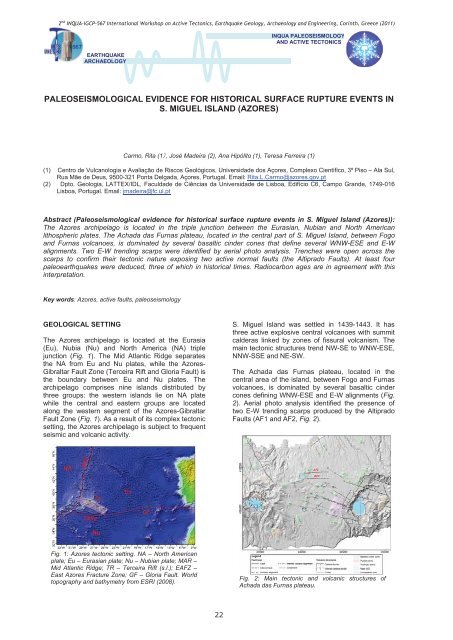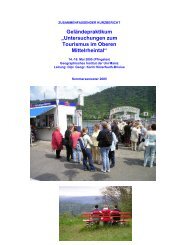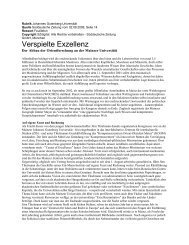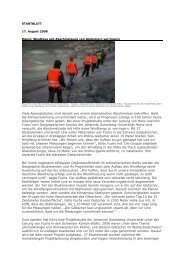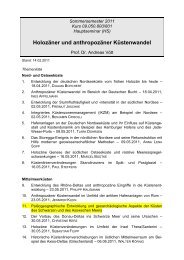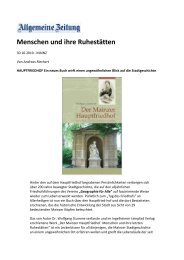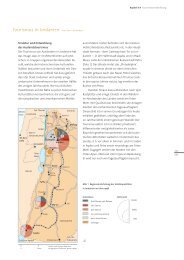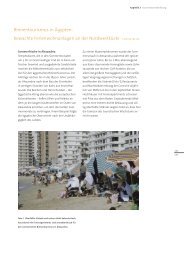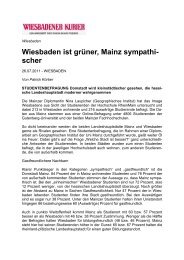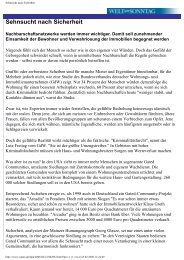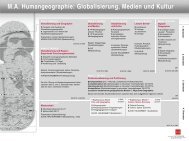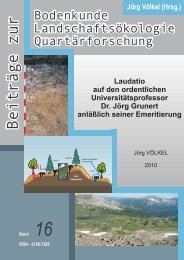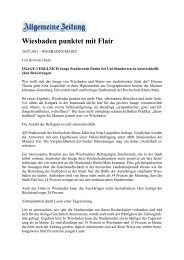Proceedings - Johannes Gutenberg-Universität Mainz
Proceedings - Johannes Gutenberg-Universität Mainz
Proceedings - Johannes Gutenberg-Universität Mainz
You also want an ePaper? Increase the reach of your titles
YUMPU automatically turns print PDFs into web optimized ePapers that Google loves.
2 nd INQUA-IGCP-567 International Workshop on Active Tectonics, Earthquake Geology, Archaeology and Engineering, Corinth, Greece (2011)<br />
EARTHQUAKE<br />
ARCHAEOLOGY<br />
INQUA PALEOSEISMOLOGY<br />
AND ACTIVE TECTONICS<br />
PALEOSEISMOLOGICAL EVIDENCE FOR HISTORICAL SURFACE RUPTURE EVENTS IN<br />
S. MIGUEL ISLAND (AZORES)<br />
Carmo, Rita (1, José Madeira (2), Ana Hipólito (1), Teresa Ferreira (1)<br />
(1) Centro de Vulcanologia e Avaliação de Riscos Geológicos, Universidade dos Açores, Complexo Científico, 3º Piso – Ala Sul,<br />
Rua Mãe de Deus, 9500-321 Ponta Delgada, Açores, Portugal. Email: Rita.L.Carmo@azores.gov.pt<br />
(2) Dpto. Geologia, LATTEX/IDL, Faculdade de Ciências da Universidade de Lisboa, Edifício C6, Campo Grande, 1749-016<br />
Lisboa, Portugal. Email: jmadeira@fc.ul.pt<br />
Abstract (Paleoseismological evidence for historical surface rupture events in S. Miguel Island (Azores)):<br />
The Azores archipelago is located in the triple junction between the Eurasian, Nubian and North American<br />
lithospheric plates. The Achada das Furnas plateau, located in the central part of S. Miguel Island, between Fogo<br />
and Furnas volcanoes, is dominated by several basaltic cinder cones that define several WNW-ESE and E-W<br />
alignments. Two E-W trending scarps were identified by aerial photo analysis. Trenches were open across the<br />
scarps to confirm their tectonic nature exposing two active normal faults (the Altiprado Faults). At least four<br />
paleoearthquakes were deduced, three of which in historical times. Radiocarbon ages are in agreement with this<br />
interpretation.<br />
Key words: Azores, active faults, paleoseismology<br />
GEOLOGICAL SETTING<br />
The Azores archipelago is located at the Eurasia<br />
(Eu), Nubia (Nu) and North America (NA) triple<br />
junction (Fig. 1). The Mid Atlantic Ridge separates<br />
the NA from Eu and Nu plates, while the Azores-<br />
Gibraltar Fault Zone (Terceira Rift and Gloria Fault) is<br />
the boundary between Eu and Nu plates. The<br />
archipelago comprises nine islands distributed by<br />
three groups: the western islands lie on NA plate<br />
while the central and eastern groups are located<br />
along the western segment of the Azores-Gibraltar<br />
Fault Zone (Fig. 1). As a result of its complex tectonic<br />
setting, the Azores archipelago is subject to frequent<br />
seismic and volcanic activity.<br />
S. Miguel Island was settled in 1439-1443. It has<br />
three active explosive central volcanoes with summit<br />
calderas linked by zones of fissural volcanism. The<br />
main tectonic structures trend NW-SE to WNW-ESE,<br />
NNW-SSE and NE-SW.<br />
The Achada das Furnas plateau, located in the<br />
central area of the island, between Fogo and Furnas<br />
volcanoes, is dominated by several basaltic cinder<br />
cones defining WNW-ESE and E-W alignments (Fig.<br />
2). Aerial photo analysis identified the presence of<br />
two E-W trending scarps produced by the Altiprado<br />
Faults (AF1 and AF2, Fig. 2).<br />
Fig. 1: Azores tectonic setting. NA – North American<br />
plate; Eu – Eurasian plate; Nu – Nubian plate; MAR –<br />
Mid Atlantic Ridge; TR – Terceira Rift (s.l.); EAFZ –<br />
East Azores Fracture Zone; GF – Gloria Fault. World<br />
topography and bathymetry from ESRI (2008).<br />
Fig. 2: Main tectonic and volcanic structures of<br />
Achada das Furnas plateau.<br />
22


